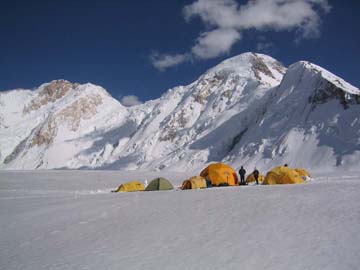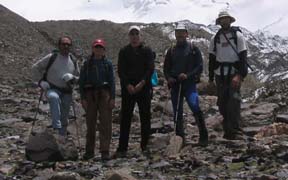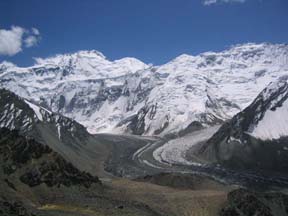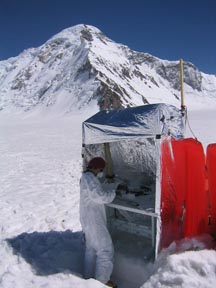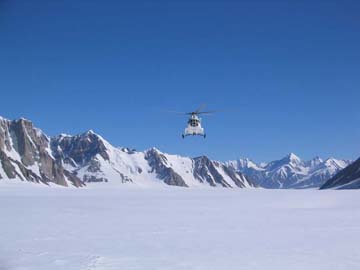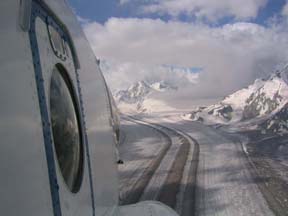
Reconnaissance Research in the Pamir Mountains, Tajikistan
Reconnaissance Research in the Pamir Mountains, Tajikistan
Susan Kaspari and Bjorn Gringholm, UMaine
Dr. Vladimir Aizen, University of Idaho
Arzhan Surazakov and Dan Joswiak, UIdaho
July 16 – August 6, 2005
The high elevation snowfields of the Pamir and Tien Shan contain robust records documenting: moisture advection into central Asia from the Atlantic and Arctic; dynamics of the westerly jet stream, the Siberian High, and Asian monsoon; and naturally and humanly forced environmental change over central Asia.
The current spatial coverage of ice-core records from the Altai, Tibet and the Himalaya is inadequate to document climatic and environmental changes over the northern region of central Asia through the Holocene, even though central Asian glaciers have been studied continuously since the 19th century by Russian scientists and despite the apparent sensitivity of this region to future climate change.
The Pamir are located in a region that influences hemispheric scale climate and is expected to experience major environmental change as a consequence of warming. Little past climate information exists from the Pamir and central Asia in general. Asia has a long history of diverse civilization and a large potential for dramatic impact by humans in the near future related to land use, water demand, and general development of society.
This field season to the Fedchenko glacier in the Pamir will be a reconnaissance trip to sample snowpits, collect shallow (10 to 20 m) ice cores, and install a meteorological station. The purpose of this field season is to acquire additional information about the site to verify that the climate signal is preserved in the cores. The shallow cores that will be collected this summer will provide the necessary data to secure funding for the Central Asia Deep Ice-Coring Project (CADIP) from international funding agencies. CADIP is a multinational effort to drill a 500-1000 meter ice core, which will be the deepest non-polar ice core ever recovered, and will provide a climatic and environmental record covering the Holocene.
Institutions in addition to the University of Idaho and University of Maine involved with the project include the China Meteorological Administration; Cold and Arid Environmental Engineering Research Institute; Chinese Academy of Sciences; Tibetan Plateau Institute; Institute for Environmental Physics, University of Heidelberg; Institute of Environmental Geochemistry, University of Heidelberg; Research Institute of Humanity and Nature; Graduate School of Environmental Studies, Nagoya University; Zenralasiatisches Institut für Angewandte Geowissenschaften in Bischkek; Paul Scherrer Institut, Labor fur Radio- und Umweltchemie; Institute of Water Resources and Hydropower, Tajik Academy of Science; and Tomsk State University.
Sunday, July 17, 2005
Susan Writes
Dushanbe, Tajikistan
Bjorn, Dan and I made it to Dushanbe without a hitch last night- all of our bags made it, and customs was a breeze. We met up with Vladimir and Arzhan last night and went to the Hotel Tajikistan and had a good meal. Today we’ve been exploring town. When we came out of the hotel there was a man with a bear on a leash- the bear had a muzzle on. Today is a big market day, so we walked to the market- tons of really beautiful fruits, vegetables, spices and bread. We enjoyed a nice lunch on the second story of an open air restaurant with really great murals, and watched a wedding going on across the street.
Tomorrow we’re going to meet with the US embassy to establish some contacts. Tuesday Vladimir will meet with the Tajik Academy of Sciences, and Wednesday we’ll head to the mountains for some acclimatization. We’re having a great time.
Monday, July 18, 2005
Bjorn Writes
Dushanbe, Tajikistan
The morning began with an early breakfast and a meeting with the expedition cook who will be accompanying us to Fedchenko Glacier. As a group we discussed the various types of food and drink we would bring into the field. It’s very important to have the proper nutrients and calories when living a cold, high altitude environment. It’s also nice to have food you think tastes good! It didn’t take us too long to decide and everyone was satisfied.
Afterwards, Susan and I dug into our packs and took out the ropes, carabiners, and harnesses and reviewed glacier travel and crevasse rescue techniques. Travelers on a glacier must be very careful of hidden dangers beneath the snow cover. If the area has not been examined and probed for crevasses all travelers should be roped up to avoid falling in one. Dan and Arzhan have been busy preparing the data logger for the meteorological station. When we return to our hotel, Susan and I will continue reviewing glacier travel and rescue techiques. Tomorrow, we will most likely begin our acclimatization in the mountains, north of Dushanbe.
Thursday, 21, 2005
Susan Writes
Dushanbe, Tajikistan
We’ve returned a day early from our acclimatization trip because our helicopter flight has been moved up one day, so we will fly by helicopter to Moskvina Base Camp at 4200 m tomorrow.
We had a fantastic time on our acclimatization trip. We drove 1.5 hours north of Dushanbe, driving along a huge beautiful river. Along the way under the trees there are platforms set up with beautiful cloth covers and cushions. Locals enjoy the shade, try and escape the heat, drink tea, and relax. We were dropped off at the entrance to a valley, and hiked 5km along a huge roaring junction with another river and stopped for lunch. On one side of the river a group of Tajik sheepherders live, and on the other is a weather station from Soviet Union times. Our cook, Vicki, is friends with the man who lives at and runs the met station. His name is Ivan, and he invited us to cook at his home and spend the night. It was a magnificent place- the small house is nestled in the valley with a stream running by, there are pools to jump in, bee hives, a garden, and beautiful stone work and wood carvings everywhere. We enjoyed a yummy late lunch by Vicki, and then went hiking for another 3 hours up the valley, and returned shortly after dark. Bjorn and I slept outside, sleeping soundly after escaping the heat of Dushanbe. This morning we had breakfast, tea and talked more with Ivan and his family about the area. The met station where he lives has the highest maximum precipitation recorded in this region of Asia – 200cm of water equivalent (that’s over 6 feet of water)! The majority of the precipitation comes from westerlies in the winter time. Ivan said that many of the glaciers are retreating, corroborating what others in Dushanbe have said. One of the reasons we are flying in to Moskvina Base Camp is that many of the roads are damaged from high glacial runoff. When we left Ivan’s house, we crossed the huge river in a cart that runs on cables stretched high above the river- we all loved that part! We hiked back down to the road, met our driver, and returned to Dushanbe to prepare for tomorrow’s flight to Moskvina.
This afternoon Vicki and Arzhan shopped for food for the next two weeks, we did some paperwork to clear us for entrance to the Pamir mountains because it is a restricted area, and had a good dinner. We are all excited to get to the mountains. We will spend approximately four days at Moskvina Base Camp acclimatizing. Moskvina is near Samoni peak, which is 7455m tall. We will then fly to the head of Fedchenko glacier at 5500m where we will stay for a week doing research. Our objective include instalingl the meteorological station to measure temperature, wind speed and direction, and pressure; drill ice cores, and do other snow studies.
Friday, July 22, 2005
Susan reports from
Moskvina, Tajikistan
Today we boarded an enormous Russian helicopter for a 2 hour flight to our base camp at Moskvina. We flew over gorgeous country with lots of magnificent glaciers. Along the way we saw many small human settlements with yurtsand herds of animals.
We will spend 3 to 4 days here hiking and getting accustomed to the altitude, then we plan to go on to the head of Fedchenko glacier to begin our field work. These acclimation stops are very important; when you go from sea level to about 5500 meters (~18,000 feet) your body needs time to adjust to the lower oxygen concentration and the lower air pressure.
Sunday, July 24, 2005
Bjorn Reports
Moskvina Base Camp, Tajikistan
We are currently at base camp and things are going very well. The scenery is quite spectacular here with Samoni peak (7,450 meters or 24,000 feet) within view. This is a very popular base camp for climbing groups; yesterday and today groups from Israel, Norway and Spain have all joined us here.
The team has been doing day hikes to help us get better acclimated to the altitude. We have been looking at the moraines and glaciers, and working on our crevasse rescue techniques, and Vladimir, Dan and Arzhan have been working on the meteorological station.
We will be spending an additional day or two at Moskvina because some repair work is being done on the road that the fuel truck will travel on to deliver fuel to the helicopter refueling station. Once the fuel is delivered we will be able to fly to Fedchenko glacier and begin our work.
Tuesday, July 26, 2005
Susan reports:
Moskivina Base Camp, Tajikistan
We are still at Base Camp, and are doing well. We have a flight scheduled for early tomorrow morning to our working site on the Fedchenko glacier. We are enjoying our stay here meeting people from all over the world. As we mentioned in our last update, climbers from all over the world come here for stays of up to a month at a time.
Yesterday, Arzhan and I went on an another acclimatization hike. Today, we were working with Bjorn on glacial traveling techniques. We were particularly working on walking on glacial ablation zones (the area where a glacier is actively melting). Ablation zones are usually very rough and take some work to travel across.
We will try to check in again tomorrow to let you all know about our flight.
Wednesay, July 27, 2005
Susan reports:
Jirgital, Tajikistan
This morning we boarded the helicopter for our flight to Fedchenko glacier. However, when Vladimir showed the pilot on the map exactly were we wanted to go, things got a little complicated. Our site is harder to get into and farther than they had planned. It will require more fuel than the helicopter can carry at high altitudes to get us in and get them back.
So we have stopped in a little village called Jirgital and we will be staying here over night. Tomorrow, the helicopter company will fly in a refueling tank and position it part way to our camp. Then we will fly up and the helicopter will be able to stop and refuel on the way back down. All of our gear will stay loaded on the helicopter overnight to save us time in the morning.
They have given us a room in the airport building where we will stay tonight. This is a very small regional airport. Jirgital is a very pretty village and we should enjoy our stay.
I will report in again tomorrow.
Thursday, July 28, 2005
Susan reports:
Fedchenko Glacier
After an incredible flight this morning, we arrived safely and set up camp. Tomorrow we will find an exact location for the drill site, begin on the snow pits, and set up the meteorological station. Tonight Bjorn and I began a snow sublimation study for Margrit. We plan to begin working early tomorrow morning.
This is a stunningly beautiful place! We are at 5,250 meters about 17,000 feet. I won’t be checking back in for a couple of days; we expect to be very busy.
Monday, August 1, 2005
Susan reports:
Fedchenko Glacier
We are doing well and are getting a lot accomplished. We’ve drilled two ice cores. The first is 12 meters long from a site at 5400 m. The second core is 9 meters long from the main Fedchencko glacier. The core quality is good, and the visual stratigraphy shows clear summer and winter layers. We’ve dug a large snowpit and it has been sampled for chemistry, isotopes, density, temperature and stratigraphy. Dan has finished setting up the meteorological station on a rock ridge very close to the first drill site.
Tomorrow we will spend the day sectioning the cores and taking samples to bring home with us. Our plan is to fly out on Wednesday.
I will try to check in again tomorrow.
Tuesday August 2, 2005
Susan reports:
Fedchenko Glacier
I have just finished sampling the second core, am tired and ready for bed. We had a very full day today, wrapping up all of our projects. Dan and Bjorn checked on the meteorological station, and it is ready to collect data for the coming year. Bjorn dug a snow pit this evening to help finish up Margit’s snow sublimation studyt. Arzhan and Vicki did a GPS survey of the suroundingsurrounding area, and installed some stakes to monitor the velocity of the glaciers. Vladimir will use these data to model the flow of the glaciers.
Our work was interrupted by a short storm this afternoon, and we spent some time relaxing and playing poker. But we were lucky, we have achieved everything we set out to do this year, and have lots of lab work ahead of us.
We hope the storm lifts by morning, so the helicopter can get in. Our plan is to fly out tomorrow. We need to catch the flight out of Dushanbe on Saturday. If we miss it, we will be delayed another week. There is only one flight a week to Munich from Dushanbe.
We are all looking forward to a hot shower.
Wed., August 3, 2005
Bjorn writes:
Dushanbe, Tajikistan
We flew into Dushanbe yesterday. We were worried we weren’t going to get off the glacier yesterday due to a small storm the day before. Fortunately, the skies cleared and we left on schedule.
We collected two cores with two different drills, the first 12 m and the second 9 m. This was a good test of our drilling equipment under these conditions and a good chance for us to hone our skills as drillers. We will take this information and make some improvements to our equipment and work on our technique.
We processed both cores and currently our samples are being stored in our hotel refrigerators. We have one more day left in Dushanbe and then it’s off to Munich. Hopefully, there will be no complications with our flight. The flight to Munich only leaves once a week. Interestingly enough, last night before I went to sleep I was watching the Russian news and I saw Gordon Hamilton talking about the Greenland glaciers. He was dubbed so I couldn’t understand what he was saying. Pretty crazy.
I hope everything is going well. See you soon.
Bjorn


